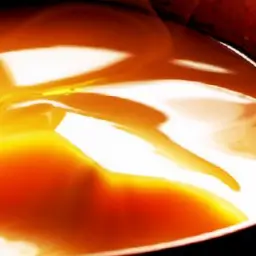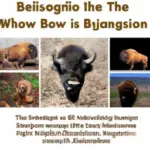Have you ever wondered what exactly bison tallow is? Look no further! This article will provide you with all the essential details you need to know about this unique product. From its composition and uses to its benefits and where to find it, we’ve got you covered. Prepare to discover the wonders of bison tallow and how it can enhance your cooking and skincare routines. So, let’s get started on this enlightening journey into the world of bison tallow!
Definition of Bison Tallow
Bison tallow refers to the fat derived from the adipose tissue of bison, which is rendered and used for various purposes. It is a versatile ingredient that has been used for centuries in cooking, skincare, and even as a fuel source. Bison tallow has a rich, creamy texture and a mild, savory flavor, making it a popular choice among chefs and skincare enthusiasts alike. With its unique nutritional profile and numerous health benefits, bison tallow has gained attention as a sustainable and healthy alternative to other animal fats.
Origination of Tallow
The use of tallow dates back thousands of years, with its origin deeply rooted in ancient civilizations. Tallow was first derived from the fat of animals such as bison, cattle, and sheep, and was an integral part of their daily lives. Prehistoric humans used tallow as a source of light and heat, as well as for cooking and preserving food. Over time, the rendering process evolved, allowing for the extraction of pure tallow from animal fat, which could be used in various applications.
Specifics about Bison Tallow
Bison tallow is prized for its unique qualities that set it apart from other animal fats. It has a higher melting point compared to other fats, making it ideal for high-heat cooking methods such as frying and roasting. The high smoke point of bison tallow ensures that it does not break down and release harmful compounds when exposed to high temperatures. Additionally, bison tallow has a mild flavor that complements a wide range of dishes without overpowering the taste of the ingredients. These characteristics make bison tallow a versatile and valuable ingredient in both culinary and skincare applications.
The Nutritional Composition of Bison Tallow
Saturated fats in Bison Tallow
Bison tallow is primarily composed of saturated fats, which make up around 40-60% of its total fat content. While saturated fats have been historically associated with adverse health effects, recent research has challenged this perception. Contrary to popular belief, saturated fats play a crucial role in the body, providing a concentrated source of energy and structural support for cells. When consumed in moderation as part of a balanced diet, saturated fats can be metabolized efficiently and even offer health benefits such as improved brain function and hormone production.
Omega-3 and Omega-6 in Bison Tallow
Bison tallow also contains omega-3 and omega-6 fatty acids, albeit in relatively lower amounts compared to vegetable oils and fish oil. However, the ratio of omega-3 to omega-6 fatty acids in bison tallow is more favorable than in many other animal fats. Omega-3 fatty acids, such as alpha-linolenic acid (ALA), have anti-inflammatory properties and are essential for brain health. Omega-6 fatty acids, such as linoleic acid, are important for normal growth and development. The balanced presence of these two essential fatty acids in bison tallow contributes to its overall nutritional value.
Vitamins and Minerals in Bison Tallow
Bison tallow contains small amounts of vitamins and minerals that can contribute to overall nutrient intake. It is a good source of vitamin E, a powerful antioxidant that helps protect cells from damage by free radicals. Additionally, bison tallow provides important minerals such as phosphorus, which is essential for bone health, and zinc, which supports immune function and wound healing. While these micronutrients may not be present in significant quantities, their inclusion in bison tallow adds to its overall nutritional composition.
Comparison of Bison Tallow with Other Animal Fats
Bison vs. Beef Tallow
Bison tallow and beef tallow share many similarities in terms of their composition and culinary uses. Both fats are rich in saturated fats and are known for their high smoke points, making them suitable for frying and roasting. However, bison tallow has a slightly different flavor profile compared to beef tallow, with a milder and less greasy taste. Some individuals prefer the taste of bison tallow over beef tallow, finding it to be more versatile in various culinary applications.
Bison vs. Lard (pork fat)
Lard, derived from pork fat, is another animal fat commonly used in cooking and baking. While both bison tallow and lard are high in saturated fats, they differ in terms of their fatty acid profile and flavor. Lard has a distinct pork flavor, which may enhance the taste of certain dishes but can be overpowering in others. In contrast, bison tallow has a milder flavor that allows the natural tastes of ingredients to shine through. Additionally, bison tallow has a higher smoke point compared to lard, making it preferable for high-heat cooking methods.
Bison vs. Duck Fat
Duck fat, renowned for its rich flavor and velvety texture, is often considered a gourmet ingredient in the culinary world. While duck fat and bison tallow both offer unique flavors and desirable cooking properties, they differ in terms of their nutritional composition. Duck fat contains a higher proportion of monounsaturated fats compared to bison tallow, which contributes to its distinct taste and texture. Additionally, duck fat has a lower smoke point compared to bison tallow, making it more suitable for sautéing and roasting at moderate temperatures.
Process of Rendering Bison Tallow
Raw Material Preparation
The process of rendering bison tallow begins with the collection of bison fat. This fat is carefully trimmed and separated from any undesirable tissue or impurities. It is important to use high-quality fat from healthy sources to ensure the final product is of the highest quality.
Rendering Phase
After the raw material preparation, the fat is heated at a low temperature to melt it down into a liquid state. This can be done in a large pot or through specialized equipment designed for rendering fats. The rendered fat is then strained to remove any sediments or impurities, leaving behind pure bison tallow that is ready for further processing.
Filtration and Purification
To ensure the purity and clarity of the final product, the rendered bison tallow undergoes a process of filtration and purification. This involves passing the liquid tallow through various filters and sieves to remove any remaining particles or impurities. The resulting tallow is smooth, clean, and ideal for culinary and skincare applications.
Storage and Packaging of Bison Tallow
Once the bison tallow has been rendered, filtered, and purified, it is ready for storage and packaging. It is important to store the tallow in a cool, dry place away from direct sunlight to maintain its quality and prolong its shelf life. Packaging may vary, but common options include glass jars or sealed containers that prevent exposure to oxygen, light, and moisture.
Health Benefits of Bison Tallow
Skin Health
Bison tallow has long been valued for its nourishing and moisturizing properties, making it a popular ingredient in skincare products. It contains essential fatty acids that help restore the skin’s natural moisture barrier, reducing dryness and promoting a healthy complexion. The high vitamin E content in bison tallow also contributes to its skin-healing properties, helping to soothe inflammation, heal wounds, and improve overall skin health.
Heart Health
Contrary to outdated beliefs, research has shown that moderate consumption of saturated fats from sources like bison tallow can be part of a heart-healthy diet. Saturated fats play a crucial role in maintaining healthy cholesterol levels, improving insulin sensitivity, and reducing the risk of heart disease. The balanced fatty acid profile of bison tallow, combined with its nutrient content, can contribute to a well-rounded diet that supports cardiovascular health.
Cognitive Health
The presence of omega-3 fatty acids in bison tallow makes it beneficial for cognitive health and brain function. Omega-3 fatty acids are essential for the development and maintenance of the brain, with research suggesting that they may help reduce the risk of cognitive decline and improve memory and cognitive performance. Incorporating bison tallow into your diet can support optimal brain health and function.
Inflammation and Immunity
The omega-3 fatty acids and antioxidants present in bison tallow contribute to its anti-inflammatory properties. Chronic inflammation is linked to various health conditions, including heart disease, arthritis, and certain types of cancer. By incorporating bison tallow into your diet as part of a balanced, nutrient-rich eating plan, you can help combat inflammation and support a strong immune system.
Potential Health Risks of Bison Tallow
High in Saturated Fats
While there is evidence to suggest that moderate consumption of saturated fats is not linked to adverse health effects, it is essential to consume bison tallow in moderation as part of a balanced diet. Excessive intake of saturated fats can contribute to weight gain, elevated cholesterol levels, and increased risk of heart disease. Like any fat, bison tallow should be enjoyed in moderation and as part of a varied and nutrient-rich eating plan.
Potential Allergic Reactions
Individuals with known allergies to bison or other animal fats may experience allergic reactions when using or consuming products containing bison tallow. It is important to read product labels carefully to identify potential allergens and consult with a healthcare professional if you have any concerns or known allergies.
Risks for Certain Health Conditions
Individuals with certain health conditions, such as obesity, diabetes, or existing heart disease, should exercise caution when incorporating bison tallow or any fat into their diet. It is important to work with a healthcare professional or registered dietitian to determine an appropriate dietary plan based on individual health needs and goals.
Usage of Bison Tallow in Cooking
Frying and Sauteing
The high smoke point and flavor profile of bison tallow make it an excellent choice for frying and sautéing. It can withstand high temperatures without breaking down or imparting off-flavors to the food. Whether you’re frying chicken, sautéing vegetables, or creating crispy french fries, bison tallow provides a delicious and nutritious alternative to other cooking oils.
Making Pastries
In baking, bison tallow can add a unique touch and enhance the texture of pastries. It can be used as a substitute for butter or vegetable shortening in recipes, providing a rich, moist, and flaky result. From pie crusts to biscuits, incorporating bison tallow into your baked goods can elevate the taste and create a memorable culinary experience.
Roasting and Grilling
When it comes to roasting or grilling meats and vegetables, bison tallow can be an excellent choice. Its high smoke point ensures that the food retains its moisture and develops a delicious golden crust. Whether you’re roasting a whole chicken or grilling a juicy steak, bison tallow adds a flavorful touch that elevates your dishes to new heights.
Usage of Bison Tallow in Skincare
Tallow as a Moisturizer
Bison tallow’s high concentration of fatty acids makes it an excellent natural moisturizer for the skin. When applied topically, it helps to create a protective barrier that locks in moisture, leaving the skin feeling soft and supple. Its nourishing properties make it particularly beneficial for dry, sensitive, or mature skin types.
Tallow in Lip Care Products
For those with dry or chapped lips, lip care products containing bison tallow can provide relief. The emollient properties of bison tallow help to soothe and heal cracked lips, providing long-lasting hydration. Whether in the form of lip balm, lip gloss, or lip butter, bison tallow can help keep your lips soft and smooth.
Tallow in Soaps and Lotions
Bison tallow is a versatile ingredient in skincare formulations, such as soaps and lotions. It contributes to the creamy texture and moisturizing properties of these products, leaving the skin feeling hydrated and nourished. Additionally, the vitamin E content in bison tallow helps to protect the skin from free radicals and environmental damage.
How to Store Bison Tallow
Short-term Storage Methods
For short-term storage, bison tallow can be kept in a cool, dark pantry or kitchen cabinet away from direct sunlight. It is important to ensure that the container is tightly sealed to prevent exposure to air and moisture. Using a clean spoon or spatula for scooping out the desired amount can help maintain the quality and extend the shelf-life of the remaining tallow.
Long-term Storage Methods
To prolong the shelf life of bison tallow, it can be stored in the refrigerator or freezer. For refrigeration, place the tallow in an airtight container and store it in the coldest part of the refrigerator, such as the back. Freezing bison tallow involves placing it in a freezer-safe container and storing it in the freezer compartment. When properly stored, bison tallow can remain usable for several months.
Signs of Bison Tallow Going Bad
It is crucial to regularly check the quality of stored bison tallow to ensure it hasn’t gone bad. Signs that the tallow may have spoiled include an off odor, an unusual appearance (such as discoloration or the presence of mold), and a rancid taste. If you notice any of these signs, it is best to discard the tallow to prevent any potential health risks.
Does Bison Tallow Come from the Weight of a Bison?
Bison tallow does not come from the weight of a bison. Tallow is a fatty substance extracted from the adipose tissue of the bison. It is commonly used in cooking and skincare products. To accurately obtain bison tallow, it is essential to adhere to proper bison weight measurements.
Environmental Impact of Bison Tallow Production
Energy Consumption in Production
The production of bison tallow requires energy for processes such as rendering, filtration, and packaging. While the exact energy consumption can vary depending on the scale and methods used, efforts should be made to minimize energy usage through efficient equipment and sustainable practices. Implementing renewable energy sources in the production process can also help reduce the environmental impact.
Waste Management and Byproducts
The rendering process results in byproducts such as protein meals, which can be repurposed for animal feed or fertilizer. It is important to manage these byproducts responsibly and explore sustainable options for their utilization. Proper waste management practices, such as recycling and composting, can further minimize the environmental impact associated with bison tallow production.
Impact on Wildlife and Biodiversity
Sustainable sourcing and production practices are vital to minimize the impact on wildlife and biodiversity. When sourcing bison fat, it is crucial to ensure responsible and ethical practices that prioritize animal welfare and conservation. Supporting bison ranches and farms that adhere to sustainable and humane practices helps protect the natural habitat and biodiversity of these magnificent animals.
In conclusion, bison tallow is a versatile and nutritious ingredient that offers unique flavor and beneficial properties. From cooking to skincare, it can enhance the taste of dishes and provide nourishment to the skin. While it is essential to consume bison tallow in moderation due to its high saturated fat content, when enjoyed as part of a balanced diet, it can contribute to overall health and well-being. By understanding the process of rendering bison tallow and its environmental impact, we can make informed choices that support sustainability and ensure the longevity of this precious resource. So why not give bison tallow a try and experience its many benefits for yourself? Your taste buds and skin will thank you!










